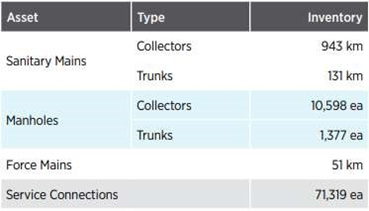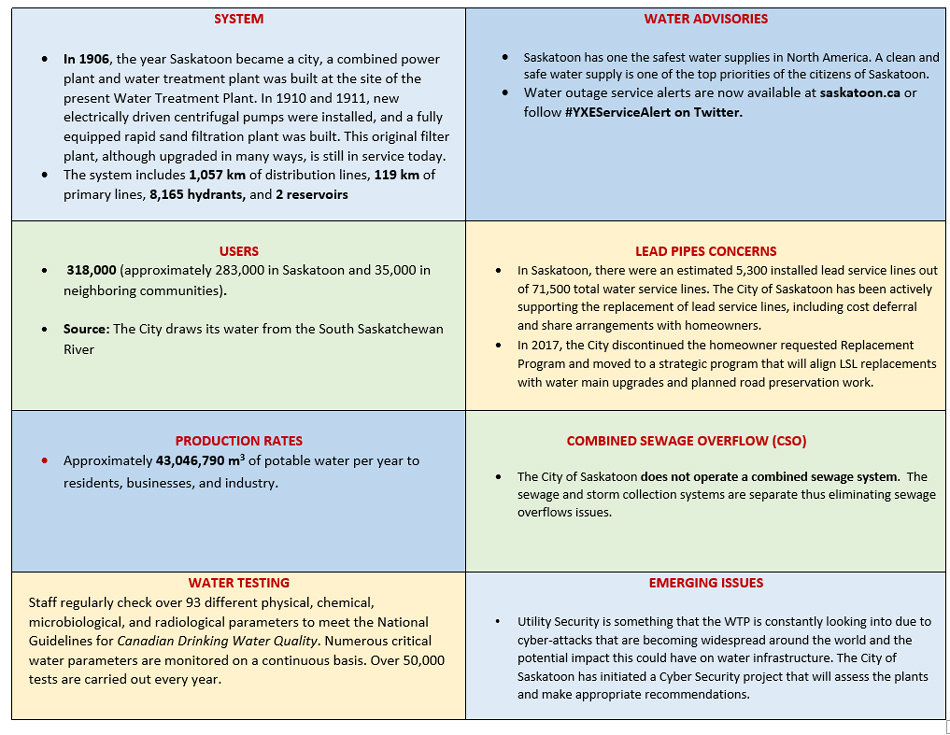2022/4/4
brought to you in part by

SASKATOON DRINKING WATER
We sent the Saskatoon's Water and Waste Service, a series of email questions. The answers are below
- Can you describe the drinking water system in Saskatoon, (distribution watermains, treatment plant, users, etc.) and the main challenges it faces?
The City of Saskatoon delivers clean, safe, and healthy drinking water to residents of Saskatoon and surrounding communities. The city ensures the quality of its water by utilizing conventional water treatment processes that involve coagulation-flocculation, clarification-sedimentation, filtration, and disinfection. The Water Treatment Plant adheres to the highest standards as set out by the Water Security Agency.
The Water Lab staff and chemists conduct over 50,000 water quality tests a year, using state-of-the-art equipment, to ensure that Saskatoon’s drinking water is clean and safe. The Water Lab maintains accreditation from CALA to ISO/IEC 17025.
The main challenges that the Water Treatment Plant faces are closely related to the aging infrastructure and the risks associated with renewal projects necessary to continue to meet operating requirements in terms of capacity, regulations, permits, etc.
One of the major challenges of maintaining the distribution/collection networks is that repair work is not necessarily distributed evenly year-to-year, which can put pressure on budgets, financial reserves, human capital, and contracted resources. This can also impact the ability to respond and make repairs in a timely manner meeting required service levels. Also, resources directed toward reactive maintenance can delay proactive maintenance and inspections. Other challenges are related to incomplete data – where the condition and status of the distributed infrastructure is undocumented.

- What is the source of drinking water?
The source of drinking water for the Saskatoon Water Treatment Plant is the South Saskatchewan River.
- Do the plants have any treatment for emerging contaminants such as PFAS, endocrine disrupters
The Saskatoon Water Treatment Plant tests for PFAS and is reported on a quarterly basis to the regulator. So far, PFAS have remained non-detectable in our watershed. As a result, the plant does not have any specific treatment process to deal with it.
OVERVIEW

- With the increase in extreme weather events and flooding, what measures is Saskatoon taking to protect its plants?
The City, to be better prepared for flooding was awarded on May 24, 2019, with $21.6 million in Government of Canada funding to implement the nine-year $54-million Flood Control Strategy.
The management of the stormwater system in Saskatoon is a vital part of the City’s infrastructure for the continuous protection of the health and safety of the public and the environment. The robust system helps mitigate flooding and erosion and prevent pollutants from reaching the City’s waterways.
Furthermore, the Gardiner Dam at Diefenbaker Lake in Saskatchewan protects the Water Treatment plant by collecting and holding water when they reach a certain level. Consequently, the WTP is protected from any potential flooding event or drought conditions.
In addition, the current electrical upgrades project at the water plant has provided additional electrical feeds to the plant and will add two 2MW generators as standby power. These will help maintain resiliency at the plant in the event of extreme weather and flooding scenarios.
- Combined sewage overflows are a common problem in cities across Canada. What is the situation in Saskatoon? What was the amount of CSO in recent years?
The City of Saskatoon does not operate a combined sewage system.
Our sewage and storm collection systems are separate thus eliminating sewage overflows issues. The stormwater runoff includes rainwater and snowmelt that flows across the land and enters a network of stormwater infrastructure in Saskatoon, including pipes, culverts, ditches, outfalls, manholes, and catch basins. Stormwater is collected via storm drains, usually located at the curbs of roads, and then moved via a piping system to large mainline pipes. Eventually, the stormwater flows into the South
Saskatchewan River. This stormwater system is a vital part of the City's infrastructure. Managing stormwater protects the health and safety of the public and the environment by mitigating flooding and erosion and preventing pollutants from reaching our waterways.
- Lead connections are also a common problem, how many lead connections do you estimate there are in Saskatoon? What is the city doing about it?
In Saskatoon, there were an estimated 5,300 installed lead service lines out of 71,500 total water service lines. The City of Saskatoon has been actively supporting the replacement of lead service lines, including cost deferral and share arrangements with homeowners. In 2017, the City discontinued the homeowner requested Replacement Program and moved to a strategic program that will align LSL replacements with water main upgrades and planned road preservation work.
The plan advances steadily with 509 Lead Service Lines replaced in 2021 and 541 LSL planned to be replaced in 2022. The City of Saskatoon’s goal is to replace all remaining LSL by 2027.
The City of Saskatoon also conducts an annual lead monitoring program as recommended by Health Canada.
- Are there other emerging issues you are looking into?
- Utility Security is something that the WTP is constantly looking into due to cyber-attacks that are becoming widespread around the world and the potential impact this could have on water infrastructure. The City of Saskatoon has initiated a Cyber Security project that will assess the plants and make appropriate recommendations.
- Global warming is a major issue around the world and the City of Saskatoon is supporting initiatives to conserve water through educational campaigns amongst other things.
- For Wastewater treatment, we are exploring alternative energy-efficient treatment processes that also achieve year-round treatment and nutrient removal.
SEE SASKATOON DRINKING WATER QUALITY AND COMPLIANCE 2020
|